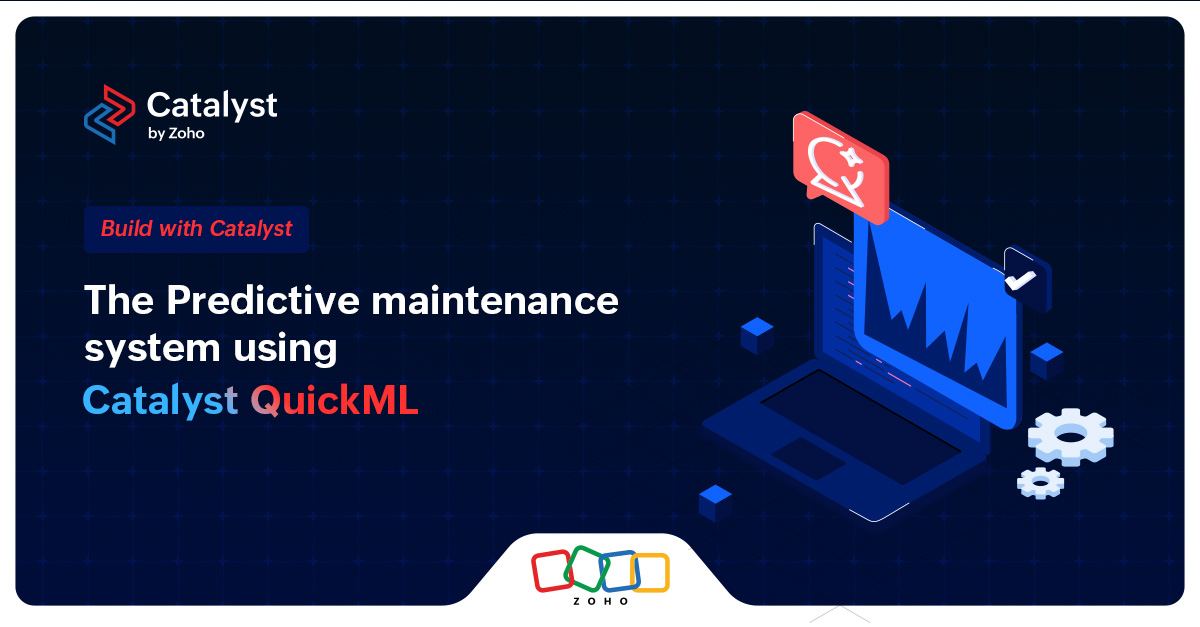- HOME
- Build with Catalyst: Predictive maintenance system using Catalyst QuickML
Build with Catalyst: Predictive maintenance system using Catalyst QuickML
- Last Updated : November 21, 2023
- 712 Views
- 3 Min Read

For our next use case in our Build with Catalyst series, we'll look at how you can build a smart, predictive maintenance system to improve operational efficiency and lower maintenance costs.
Check out our previous posts in the series to learn how you can:
Now, let's get started!
What is Catalyst QuickML?
Catalyst QuickML is an end-to-end ML platform from Catalyst to build, train, and optimize ML models, facilitating data-driven decision-making. QuickML empowers developers—with or without ML expertise—to create powerful, custom ML models and harness the power of AI.
Build a predictive maintenance system using Catalyst QuickML
Imagine this: You run a chain of restaurants with branches that spread across the globe. To ensure smooth functioning and safe food practices, it is important to ensure that all the equipment and systems in place function at their best. From refrigeration, plumbing, electricity, to dish washing, every section of the restaurant has a key role and a breakdown or fault in any of this would mean the restaurant would have to lose business till its fixed. But what if you could predict when and where you would require to get a repair or maintenance job done?
Using QuickML, you can develop a model that predicts the likelihood of repairs and maintenance jobs that you would need to carry out even before they occur. As machines and equipment are built to perform and fixed set of tasks over an approximately fixed number of time, it is possible to predict the occurrence of faults and repairs based on past repairs and maintenance data. The model can provide insights for the staff in advance so they can take proactively book and schedule maintenance jobs in a way that it does not interfere with daily business.
Catalyst components needed to achieve this:
To create a high-quality ML model in QuickML that can give solid predictions, follow these steps:
Feed the historical repairs, maintenance, and equipment data to Catalyst QuickML. This would include data like previous repair jobs, time and date of repair jobs, nature of maintenance of the repair job, brands equipment and machinery, warranty and validity related information, usage information, complaints data, and more. QuickML can help collate this data coming from different sources and as separate files into one.
Build a pipeline to produce a model that identifies trends based on maintenance and usage data. Once models are created, QuickML can figure out the data points and factors that can point to possible repairs.
Establish an endpoint using QuickML when the model is ready. This endpoint will provide a REST API to share prediction information to the right maintenance or management tool.
Query the created model each month with recent repair data to ensure it adapts to changes in new usage patterns.
Use Catalyst Functions to push predictions back to your management tool. This could help you filter the data accordingly to make bookings and appointments for maintenance.
Since you could also figure out what factor is leading to breakdowns, you can take pointed actions to elongate the lifetime of your equipment.
You can follow a similar workflow for multiple use cases. Get creative, tap into your data goldmine, and make informed business decisions.
We'd love to hear about your journey with Catalyst QuickML. Feel free to share your thoughts in the comments section or get a detailed 1:1 session. We will come back soon with another compelling use case. Stay tuned to learn how you can take full advantage of Catalyst and its capabilities.